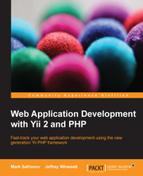Book Description
Fast-track your web application development using the new generation Yii PHP framework
In Detail
Yii is a high performance PHP framework used for rapid web application development. It is well designed, well supported, easy to learn, and easy to maintain. This book embraces the learn-by-example methodology to show you the most important features of the Yii 2 framework. Throughout the course of this book, you will build a simple real-world application; each chapter will introduce you to a new functionality and show you how to tweak your application. Instead of trying to be an all-encompassing reference about the framework, this is a walkthrough of the really important pieces of information that you have to understand in detail.
You will learn how to use Yii's active record and CRUD scaffolding to manage the data in your database. Authentication, extensions, events and behaviors, and route management are just some of the many other features of Yii that you will learn from this book. By the end of this book, you will have a basic CRM application that is all set for service!
What You Will Learn
- Build a complete application boilerplate with a single shell command and transform it into a running website with another
- Generate code for routine CRUD interface pages
- Make a vile extension just for fun and learn how to attach it to a target application
- Control and customize the output that will be sent to the client browser
- Authenticate users using a classic password-based technique and authorize them using role-based access control
- Prepare your application for multiple users and deployment to a production environment
- Answer mind-boggling SEO feature requests by modifying the route handling mechanism
Downloading the example code for this book. You can download the example code files for all Packt books you have purchased from your account at http://www.PacktPub.com. If you purchased this book elsewhere, you can visit http://www.PacktPub.com/support and register to have the files e-mailed directly to you.
Book Description
Fast-track your web application development using the new generation Yii PHP framework
In Detail
Yii is a high performance PHP framework used for rapid web application development. It is well designed, well supported, easy to learn, and easy to maintain. This book embraces the learn-by-example methodology to show you the most important features of the Yii 2 framework. Throughout the course of this book, you will build a simple real-world application; each chapter will introduce you to a new functionality and show you how to tweak your application. Instead of trying to be an all-encompassing reference about the framework, this is a walkthrough of the really important pieces of information that you have to understand in detail.
You will learn how to use Yii's active record and CRUD scaffolding to manage the data in your database. Authentication, extensions, events and behaviors, and route management are just some of the many other features of Yii that you will learn from this book. By the end of this book, you will have a basic CRM application that is all set for service!
What You Will Learn
- Build a complete application boilerplate with a single shell command and transform it into a running website with another
- Generate code for routine CRUD interface pages
- Make a vile extension just for fun and learn how to attach it to a target application
- Control and customize the output that will be sent to the client browser
- Authenticate users using a classic password-based technique and authorize them using role-based access control
- Prepare your application for multiple users and deployment to a production environment
- Answer mind-boggling SEO feature requests by modifying the route handling mechanism
Downloading the example code for this book. You can download the example code files for all Packt books you have purchased from your account at http://www.PacktPub.com. If you purchased this book elsewhere, you can visit http://www.PacktPub.com/support and register to have the files e-mailed directly to you.
Table of Contents
- Web Application Development with Yii 2 and PHP
- Table of Contents
- Web Application Development with Yii 2 and PHP
- Credits
- About the Authors
- About the Reviewers
- www.PacktPub.com
- Preface
- 1. Getting Started
- 2. Making a Custom Application with Yii 2
- 3. Automatically Generating the CRUD Code
- 4. The Renderer
- 5. User Authentication
- 6. User Authorization and Access Control
- 7. Modules
- 8. Overall Behavior
- 9. Making an Extension
- 10. Events and Behaviors
- 11. The Grid
- Dismissing of the domain layer
- Designing for the customers' index
- FEATURE – widgets
- Creating the index page for customers
- Making a base GridView for customers
- Changing the format of the column content
- FEATURE – formatter
- Making the custom GridView column for the customer audit info
- Compressing submodels related to customers into single columns
- FEATURE – GridView columns
- Implementing filtering inside GridView of customers
- Implementing sorting inside GridView of customers
- Summary
- 12. Route Management
- 13. Collaborative Work
- A. Deployment Setup with Vagrant
- B. The Active Form Primer
- Index
